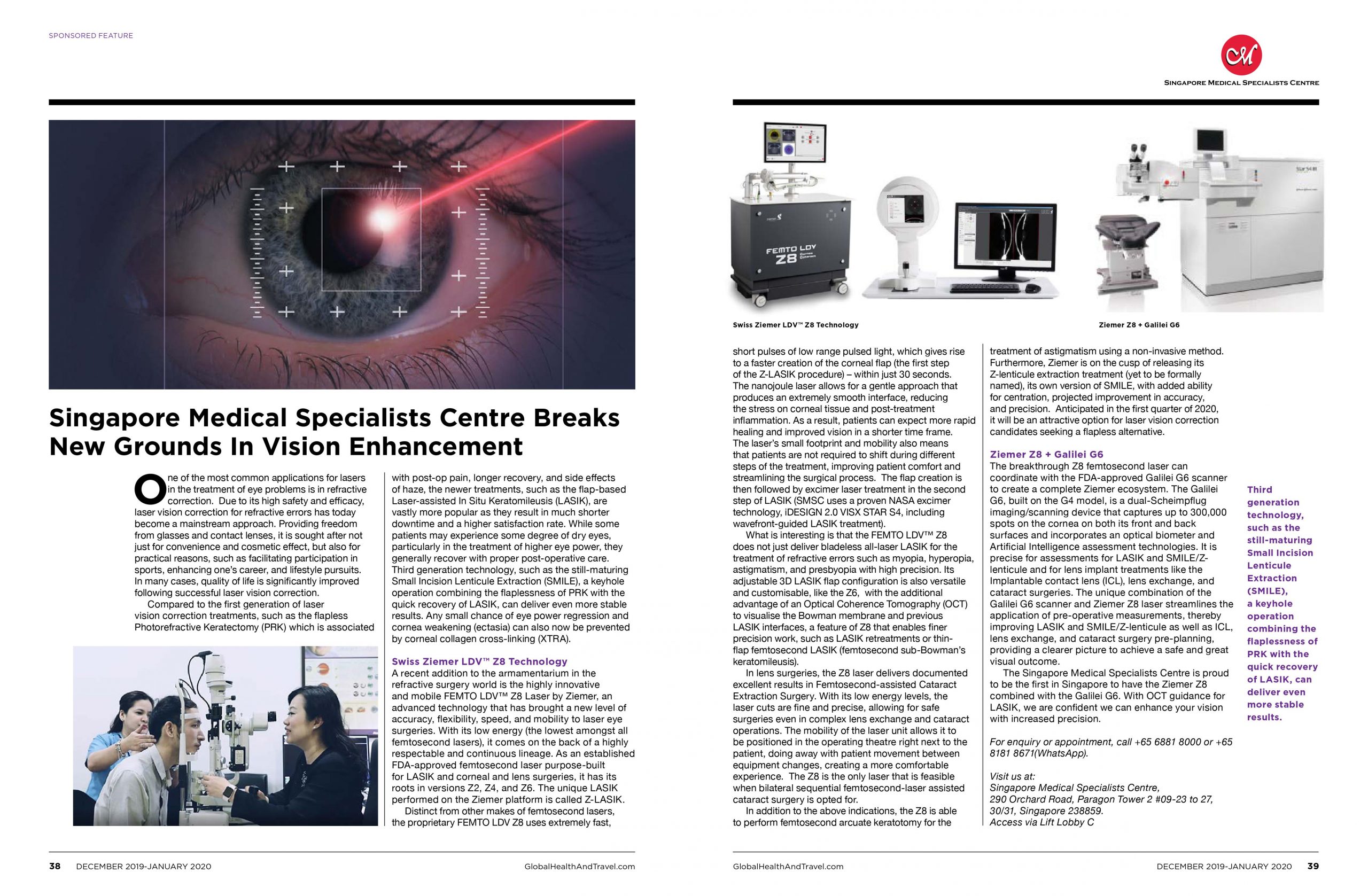One of the most common applications for lasers in the treatment of eye problems is in refractive correction. Due to its high safety and efficacy, laser vision correction for refractive errors has today become a mainstream approach. Providing freedom from glasses and contact lenses, it is sought after not just for convenience and cosmetic effect, but also for practical reasons, such as facilitating participation in sports, enhancing one’s career, and lifestyle pursuits. In many cases, quality of life is significantly improved following successful laser vision correction.
Compared to the first generation of laser vision correction treatments, such as the flapless Photorefractive Keratectomy (PRK) which is associated with post-op pain, longer recovery, and side effects of haze, the newer treatments, such as the flap-based Laser-assisted In Situ Keratomileusis (LASIK), are vastly more popular as they result in much shorter downtime and a higher satisfaction rate. While some patients may experience some degree of dry eyes, particularly in the treatment of higher eye power, they generally recover with proper post-operative care.
Third generation technology, such as the still-maturing Small Incision Lenticule Extraction (SMILE), a keyhole operation combining the flaplessness of PRK with the quick recovery of LASIK, can deliver even more stable results. Any small chance of eye power regression and cornea weakening (ectasia) can also now be prevented by corneal collagen cross-linking (XTRA).
Swiss Ziemer LDV™ Z8 Technology
A recent addition to the armamentarium in the refractive surgery world is the highly innovative and mobile FEMTO LDV™ Z8 Laser by Ziemer, an advanced technology that has brought a new level of accuracy, flexibility, speed, and mobility to laser eye surgeries. With its low energy (the lowest amongst all femtosecond lasers), it comes on the back of a highly respectable and continuous lineage. As an established FDA-approved femtosecond laser purpose-built for LASIK and corneal and lens surgeries, it has its roots in versions Z2, Z4, and Z6. The unique LASIK performed on the Ziemer platform is called Z-LASIK. Distinct from other makes of femtosecond lasers, the proprietary FEMTO LDV Z8 uses extremely fast, short pulses of low range pulsed light, which gives rise to a faster creation of the corneal flap (the first step of the Z-LASIK procedure) – within just 30 seconds.
The nanojoule laser allows for a gentle approach that produces an extremely smooth interface, reducing the stress on corneal tissue and post-treatment inflammation. As a result, patients can expect more rapid healing and improved vision in a shorter time frame. The laser’s small footprint and mobility also means that patients are not required to shift during different steps of the treatment, improving patient comfort and streamlining the surgical process. The flap creation is then followed by excimer laser treatment in the second step of LASIK (SMSC uses a proven NASA excimer technology, iDESIGN 2.0 VISX STAR S4, including wavefront-guided LASIK treatment).
What is interesting is that the FEMTO LDV™ Z8 does not just deliver bladeless all-laser LASIK for the treatment of refractive errors such as myopia, hyperopia, astigmatism, and presbyopia with high precision. Its adjustable 3D LASIK flap configuration is also versatile and customisable, like the Z6, with the additional advantage of an Optical Coherence Tomography (OCT) to visualise the Bowman membrane and previous LASIK interfaces, a feature of Z8 that enables finer precision work, such as LASIK retreatments or thinflap femtosecond LASIK (femtosecond sub-Bowman’s keratomileusis).
In lens surgeries, the Z8 laser delivers documented excellent results in Femtosecond-assisted Cataract Extraction Surgery. With its low energy levels, the
laser cuts are fine and precise, allowing for safe surgeries even in complex lens exchange and cataract operations. The mobility of the laser unit allows it to be positioned in the operating theatre right next to the patient, doing away with patient movement between equipment changes, creating a more comfortable experience. The Z8 is the only laser that is feasible when bilateral sequential femtosecond-laser assisted cataract surgery is opted for.
In addition to the above indications, the Z8 is able to perform femtosecond arcuate keratotomy for the treatment of astigmatism using a non-invasive method. Furthermore, Ziemer is on the cusp of releasing its Z-lenticule extraction treatment (yet to be formally named), its own version of SMILE, with added ability for centration, projected improvement in accuracy, and precision. Anticipated in the first quarter of 2020, it will be an attractive option for laser vision correction candidates seeking a flapless alternative.
Ziemer Z8 + Galilei G6
The breakthrough Z8 femtosecond laser can coordinate with the FDA-approved Galilei G6 scanner to create a complete Ziemer ecosystem. The Galilei G6, built on the G4 model, is a dual-Scheimpflug imaging/scanning device that captures up to 300,000 spots on the cornea on both its front and back surfaces and incorporates an optical biometer and Artificial Intelligence assessment technologies. It is precise for assessments for LASIK and SMILE/Zlenticule and for lens implant treatments like the Implantable contact lens (ICL), lens exchange, and cataract surgeries. The unique combination of the Galilei G6 scanner and Ziemer Z8 laser streamlines the application of pre-operative measurements, thereby improving LASIK and SMILE/Z-lenticule as well as ICL, lens exchange, and cataract surgery pre-planning, providing a clearer picture to achieve a safe and great visual outcome.
The Singapore Medical Specialists Centre is proud to be the first in Singapore to have the Ziemer Z8 combined with the Galilei G6. With OCT guidance for LASIK, we are confident we can enhance your vision with increased precision.
